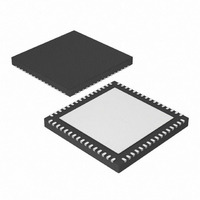DSPIC33FJ128GP706A-E/MR Microchip Technology, DSPIC33FJ128GP706A-E/MR Datasheet - Page 89

DSPIC33FJ128GP706A-E/MR
Manufacturer Part Number
DSPIC33FJ128GP706A-E/MR
Description
16 Bit MCU/DSP 40MIPS 128KB FLASH 64 QFN 9x9x0.9mm TUBE
Manufacturer
Microchip Technology
Series
dsPIC™ 33Fr
Datasheets
1.MCP3909T-ISS.pdf
(104 pages)
2.DSPIC33FJ12GP201-ISO.pdf
(90 pages)
3.DSPIC33FJ64GP206-IPT.pdf
(28 pages)
4.DSPIC33FJ64GP206A-IMR.pdf
(338 pages)
Specifications of DSPIC33FJ128GP706A-E/MR
Core Processor
dsPIC
Core Size
16-Bit
Speed
40 MIPs
Connectivity
CAN, I²C, IrDA, LIN, SPI, UART/USART
Peripherals
AC'97, Brown-out Detect/Reset, DMA, I²S, POR, PWM, WDT
Number Of I /o
53
Program Memory Size
128KB (128K x 8)
Program Memory Type
FLASH
Ram Size
16K x 8
Voltage - Supply (vcc/vdd)
3 V ~ 3.6 V
Data Converters
A/D 18x10b/12b
Oscillator Type
Internal
Operating Temperature
-40°C ~ 125°C
Package / Case
64-VFQFN, Exposed Pad
Lead Free Status / RoHS Status
Lead free / RoHS Compliant
Eeprom Size
-
Lead Free Status / RoHS Status
Lead free / RoHS Compliant
C.6
© 2009 Microchip Technology Inc.
IMPROVING MEASUREMENT PRECISION OF QUASI-SYNCHRONOUS
SAMPLING ALGORITHM
When using the quasi-synchronous sampling method for harmonic analysis and
calculation of power as well as voltage and current, strict restrictions apply for the
algorithm and compensation, (i.e., the frequency offset must not exceed 1% of the
central frequency). Precision of the result increases as the frequency offset gets less.
Measurement accuracy is not guaranteed, if this condition can not be met. Figure C-4
shows the quasi-synchronization algorithm using 3 iterations with input signal ranging
from 47.5 Hz to 52.5 Hz. The algorithm is for calculating the active power, the reactive
power and the relative error of current and voltage. Figure C-4 shows that the algorithm
works well when the frequency falls in the range of 47.5 Hz to 52.5 Hz. As the
frequency deviates from the range, the error increases significantly. Therefore, the
algorithm needs to be improved to fit into more applications with a more relaxed
restriction.
FIGURE C-4:
The quasi-sync sampling algorithm has relative high accuracy in frequency measure-
ment and the error can be less than 0.005 Hz. If the frequency range to be measured
can be segmented to make the frequency input closest to the multiple of cycle point,
and processed using appropriate quasi-sync window function and sine/cosine tale,
then the algorithm can be used for a much wider range of frequency .
Figure C-5 is the error analysis of the improved 3-iteration quasi-synchronous
algorithm at 3.2 ksps. It shows that the relative error for each result can be well
controlled when the frequency of the input signal falls in the range of 47.5 Hz to
52.5 Hz.
Figure C-5 clearly shows that the relative errors of the current, voltage, active power
and reactive power in the entire frequency range are less than 0.08%. Also, when the
input frequency is around the multiple of cycle frequencies (52.459 Hz, 51.613 Hz,
50.794 Hz, 50.0 Hz, 49.231 Hz, 48.485 Hz and 47.761 Hz), the calculateion error is
Quasi-sync Algorithm Error Analysis of 3 Iterations.
Power Calculation Theory
DS51723A-page 89











